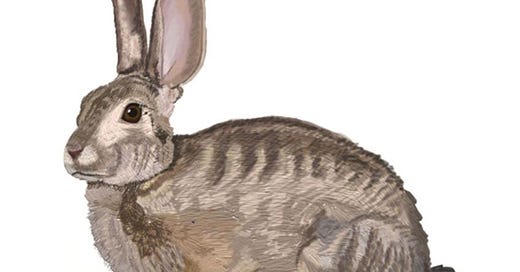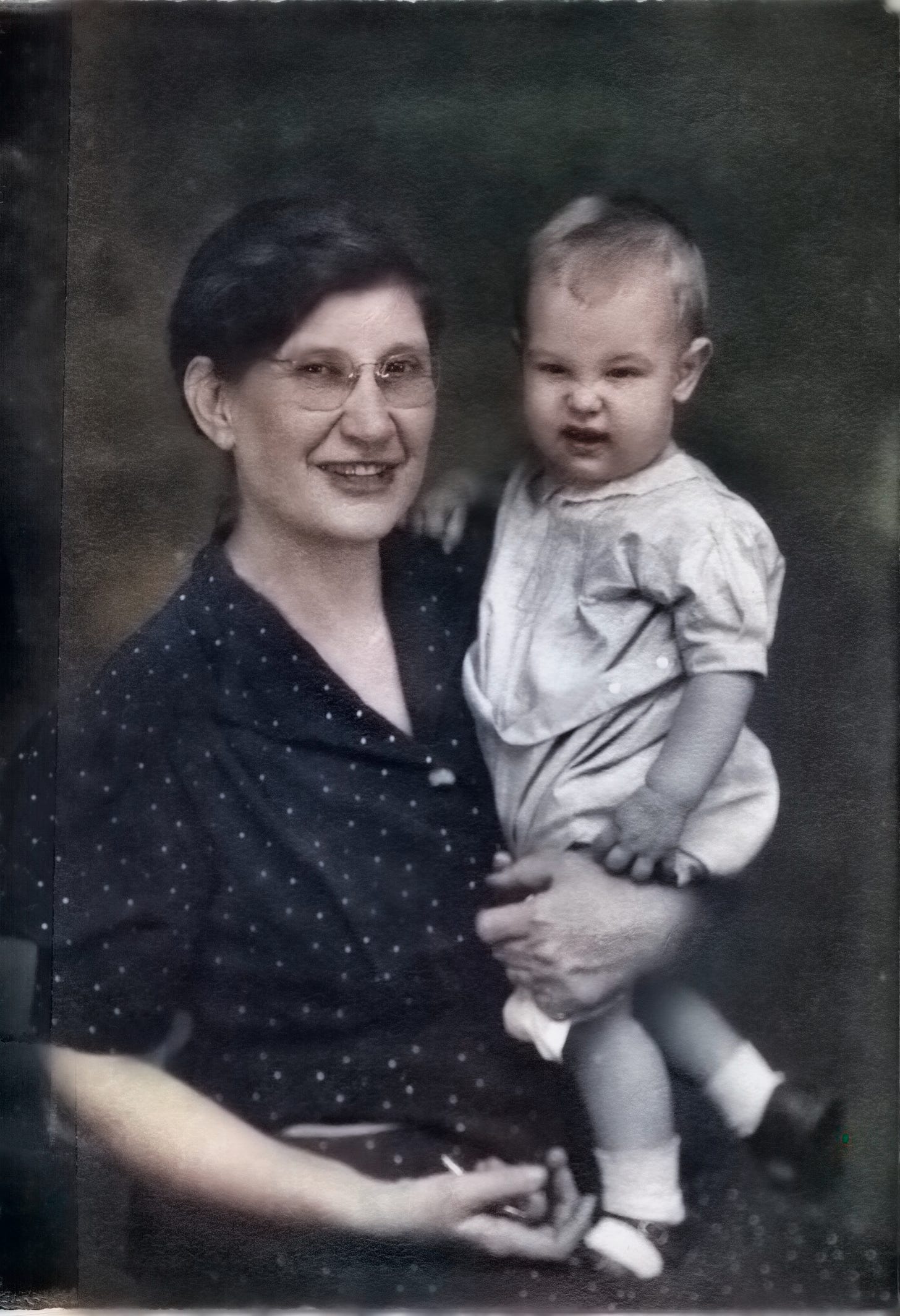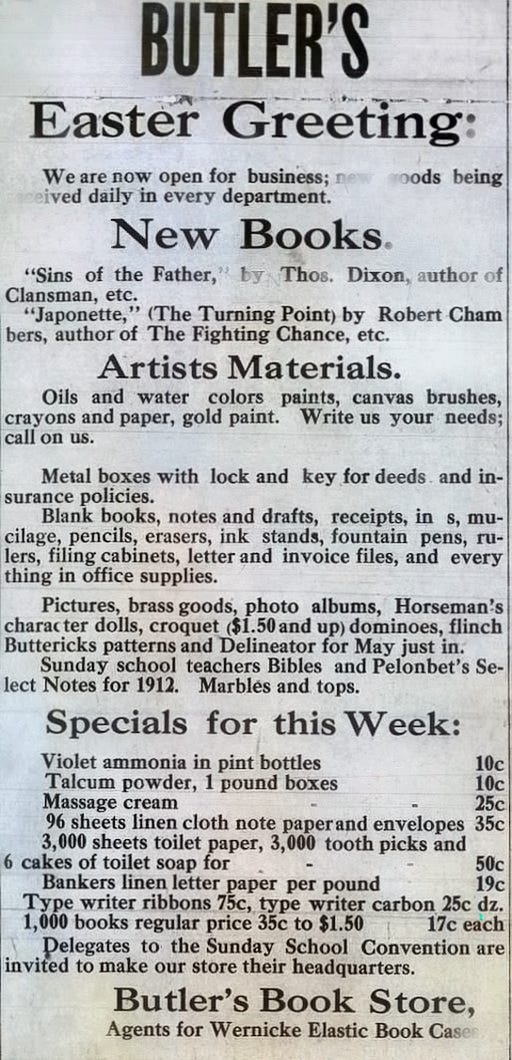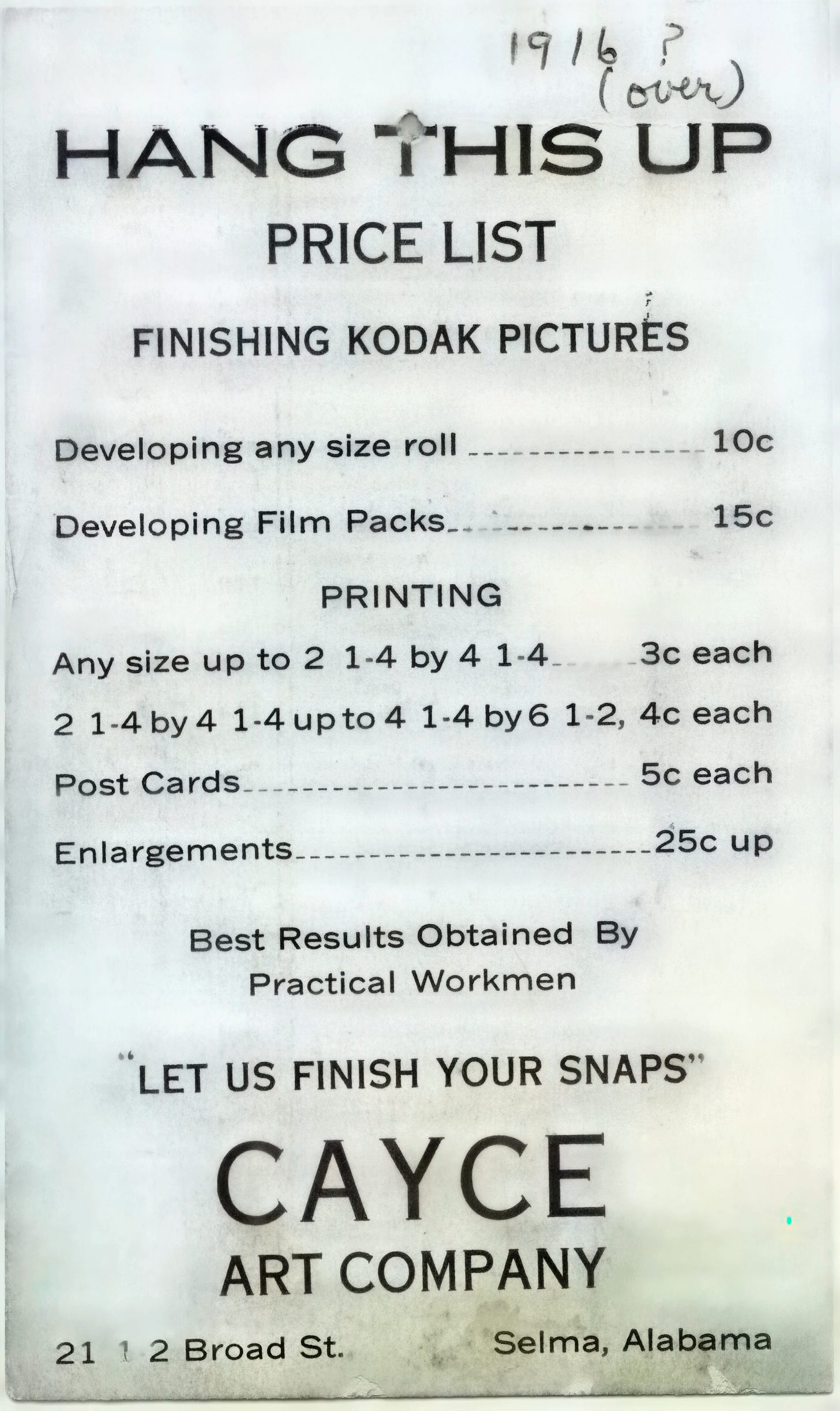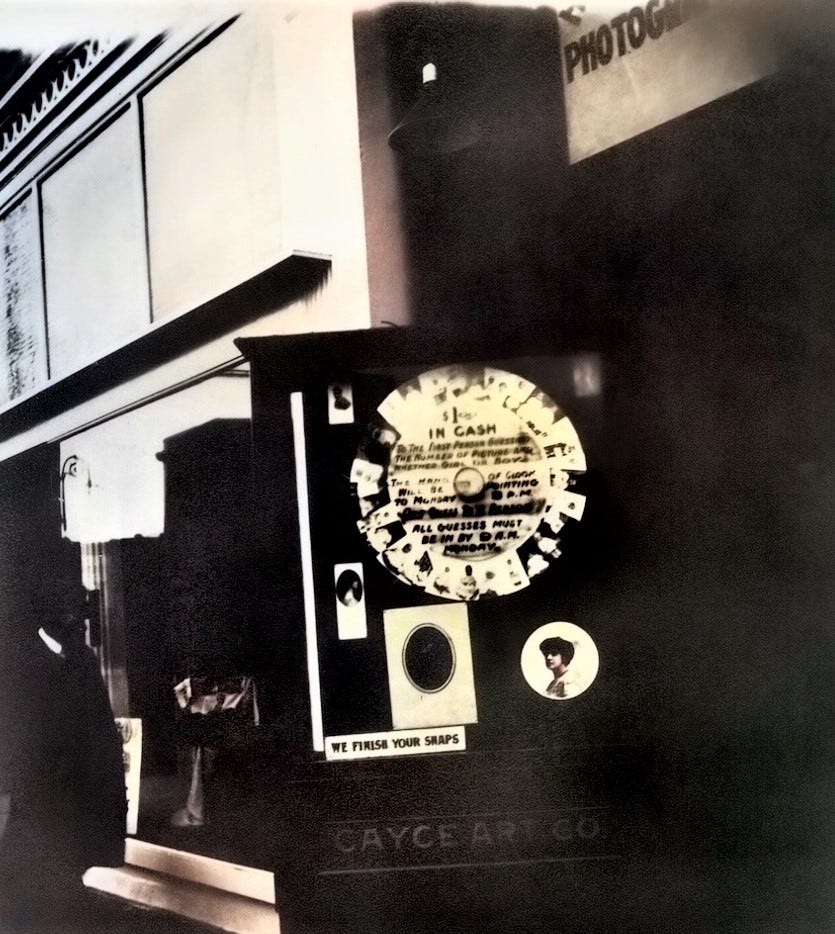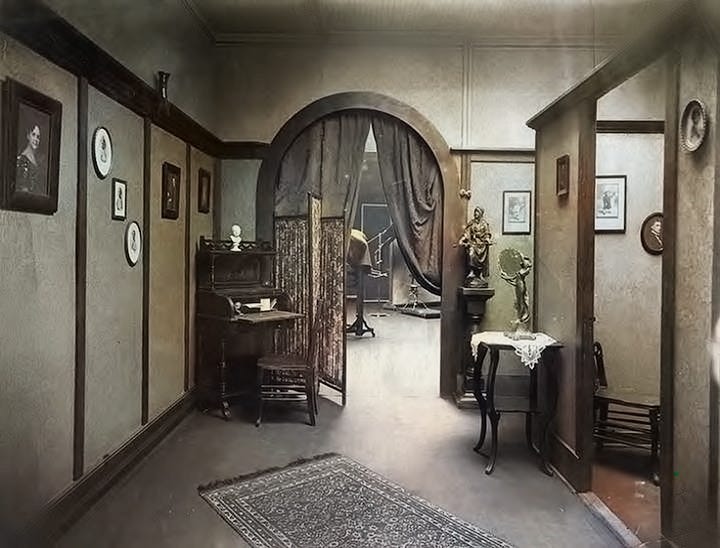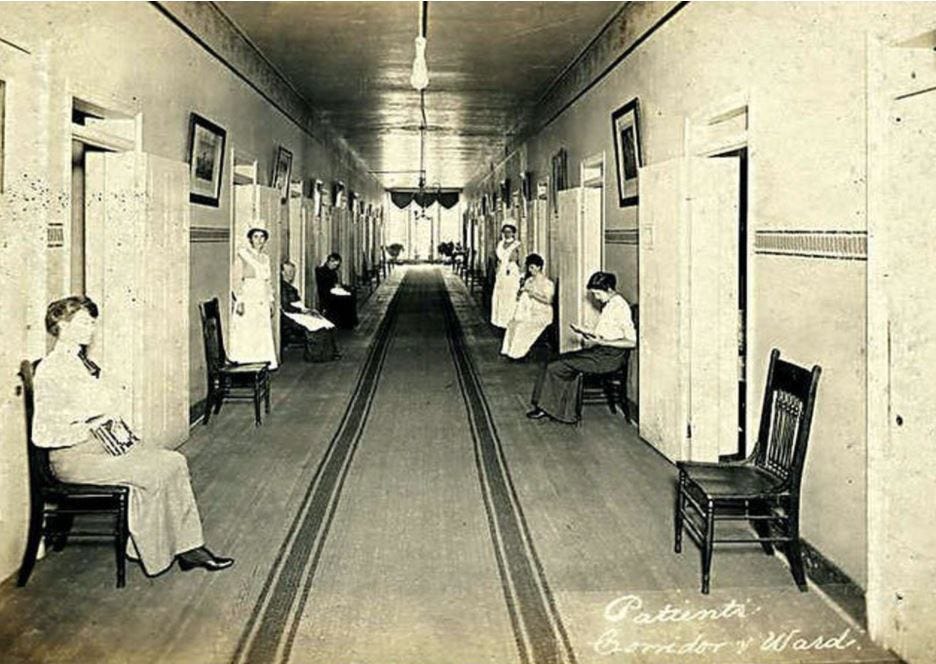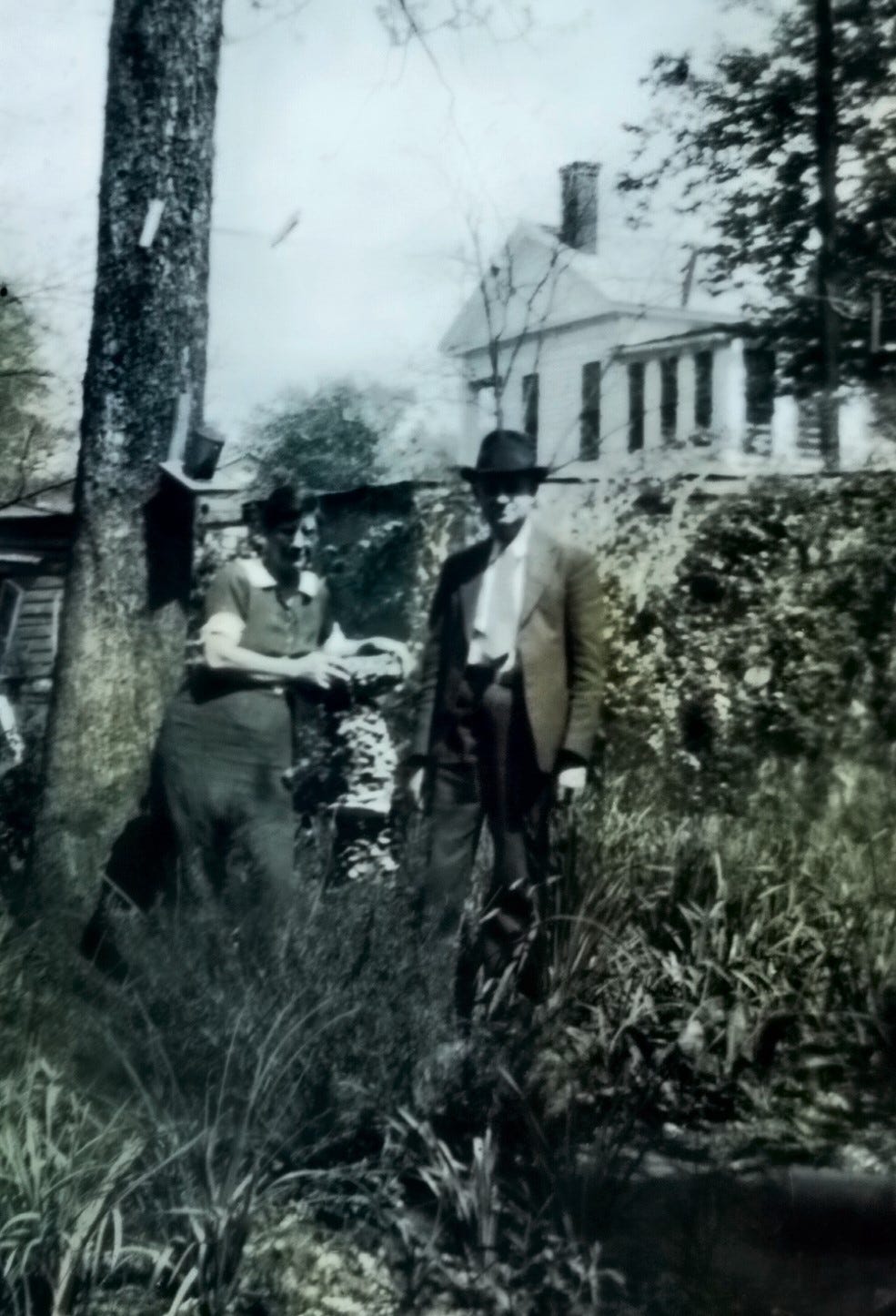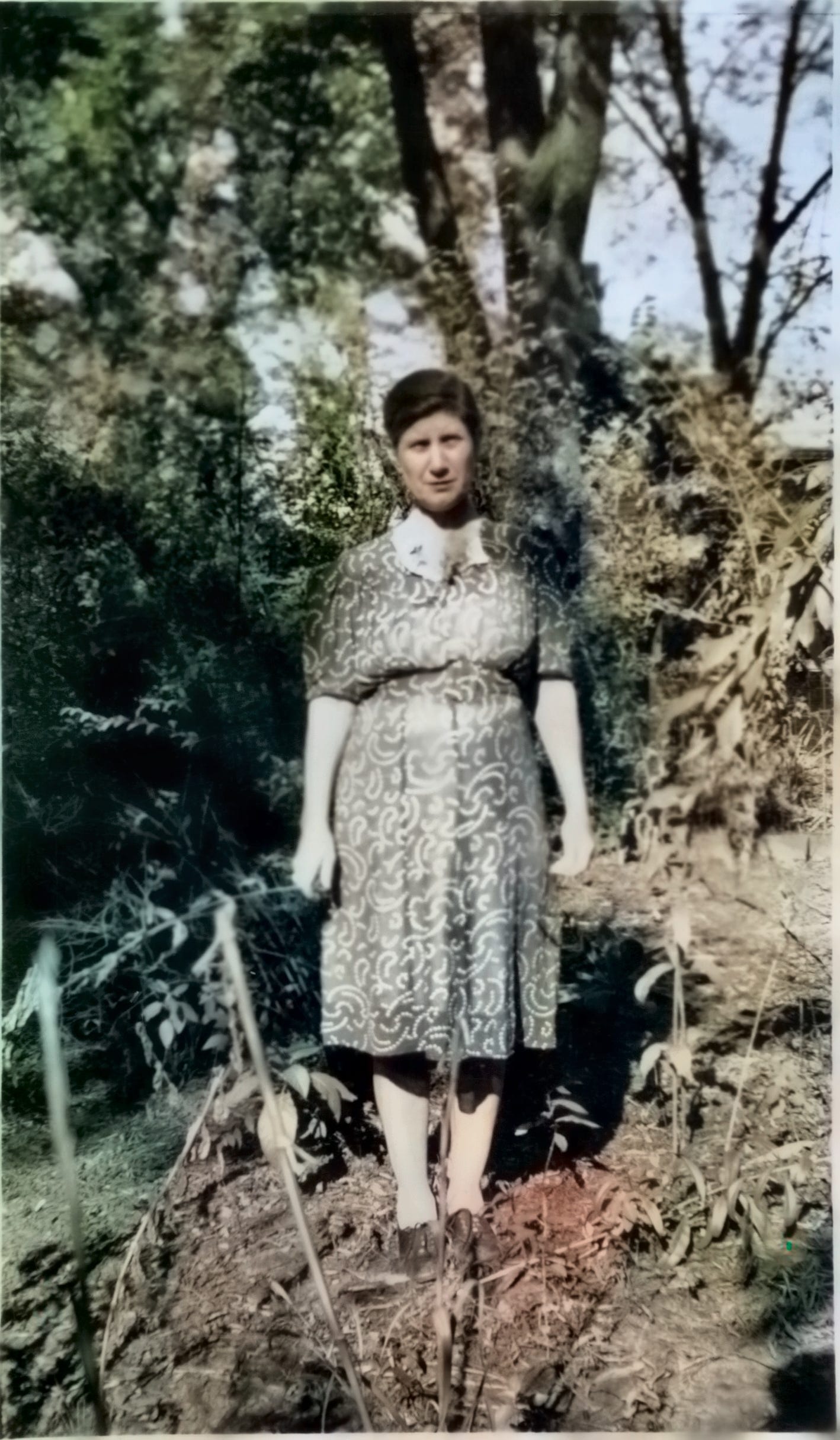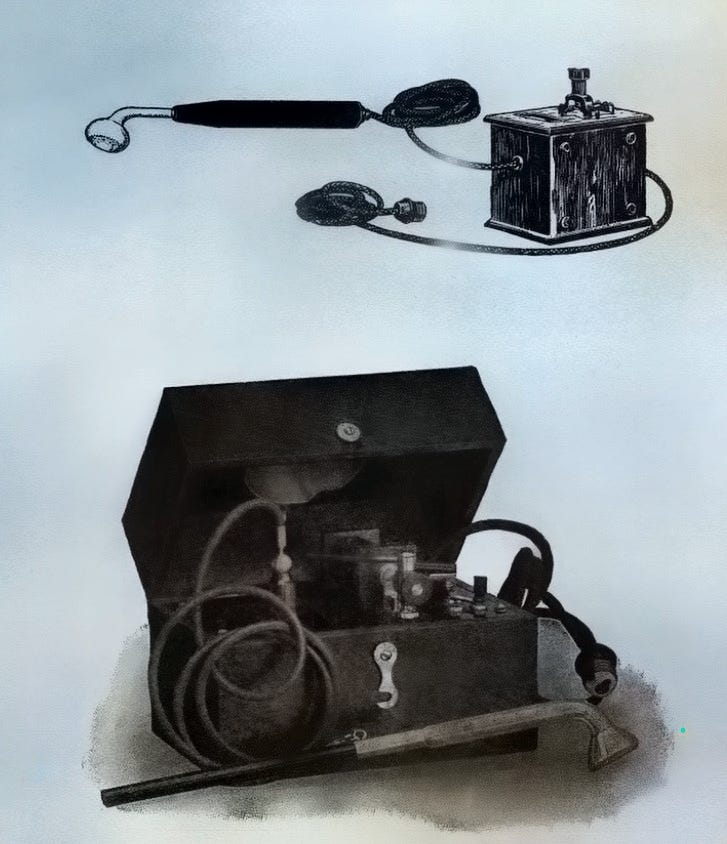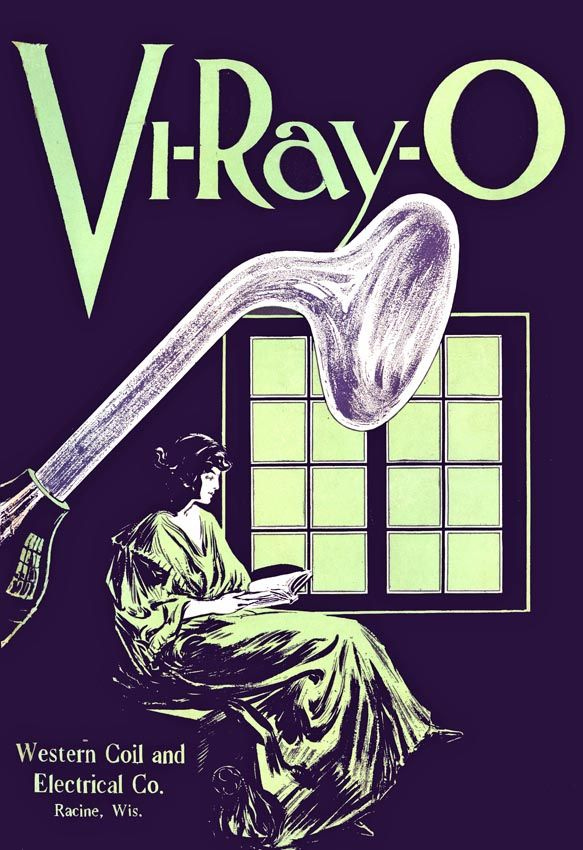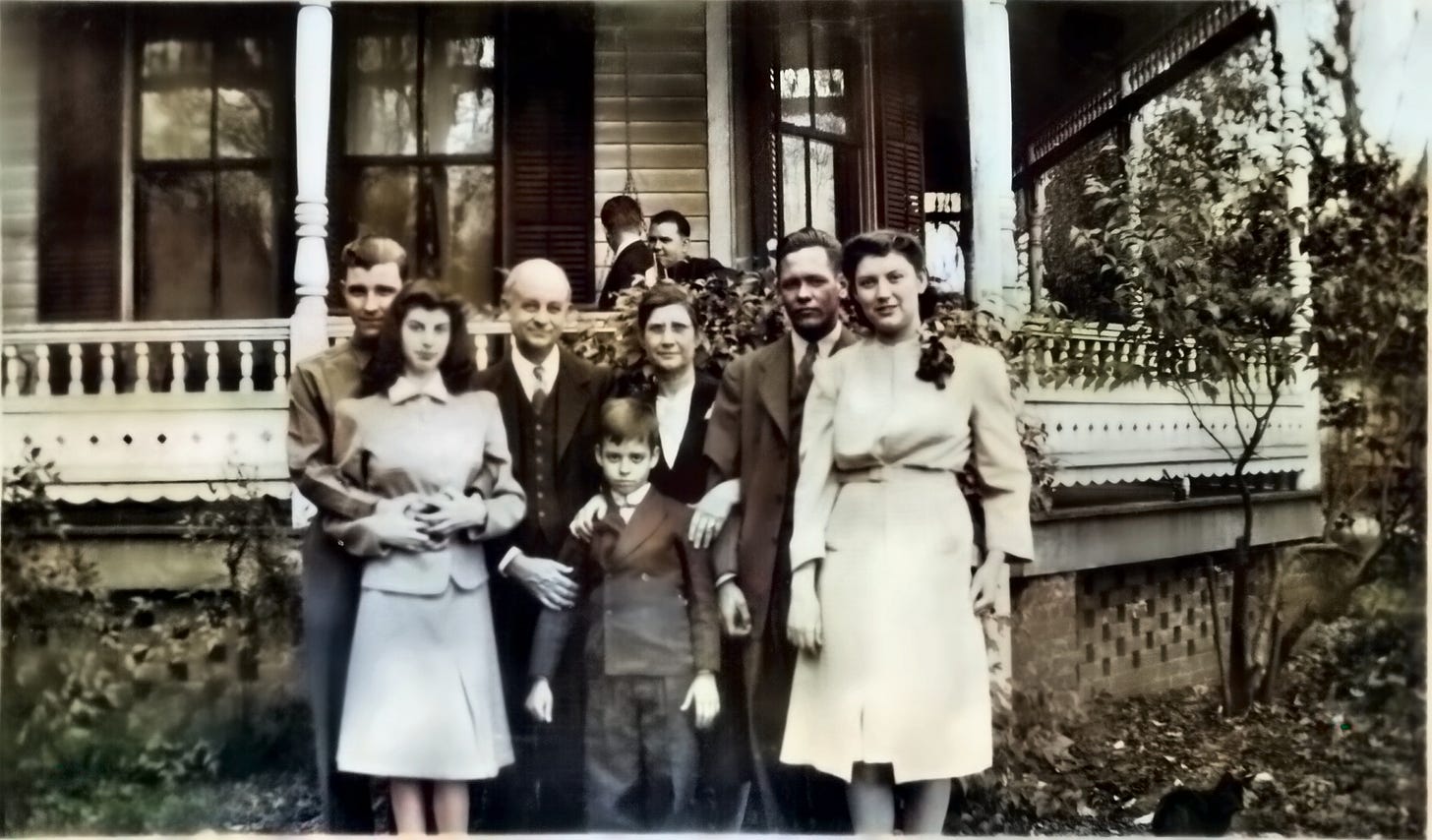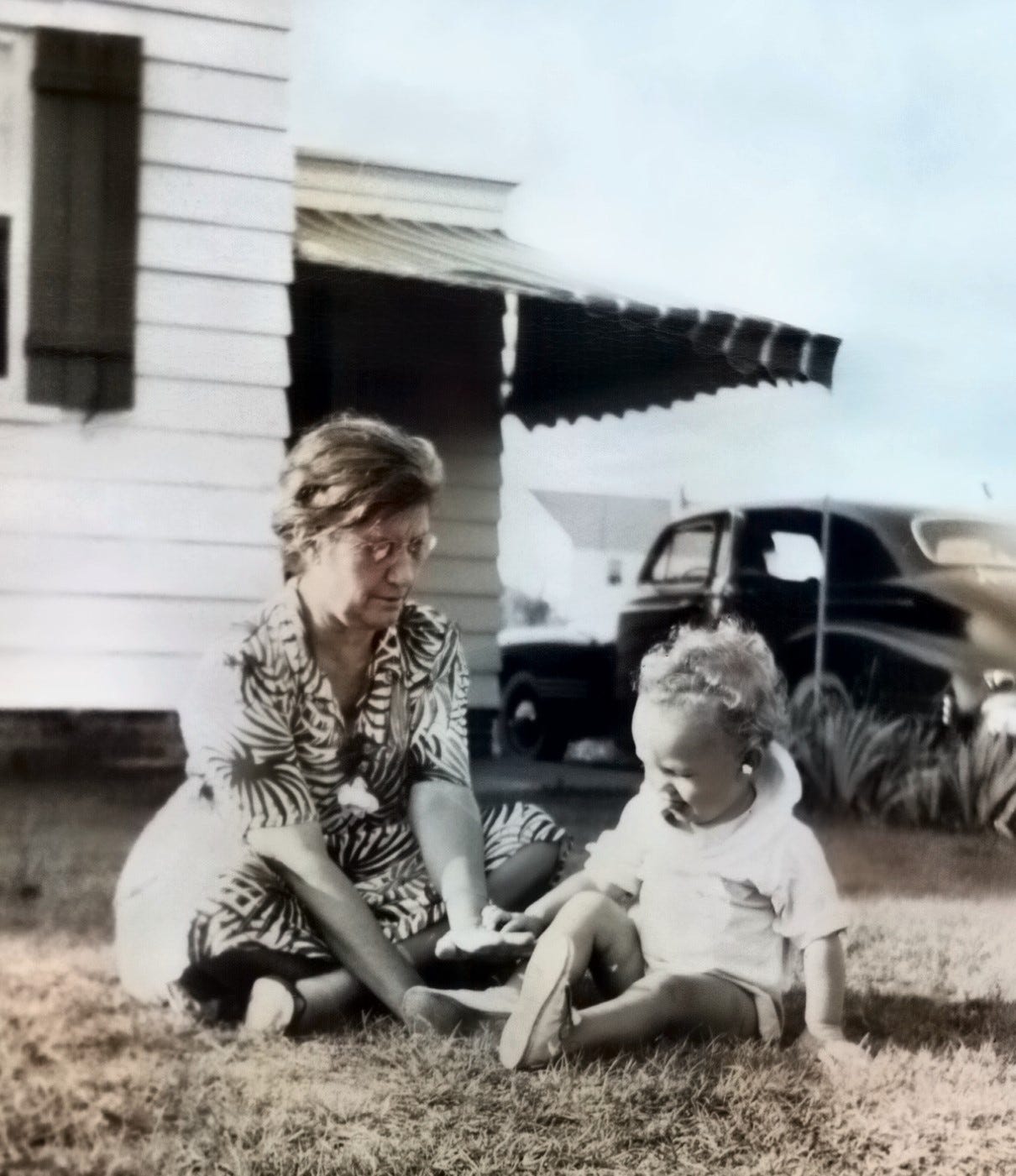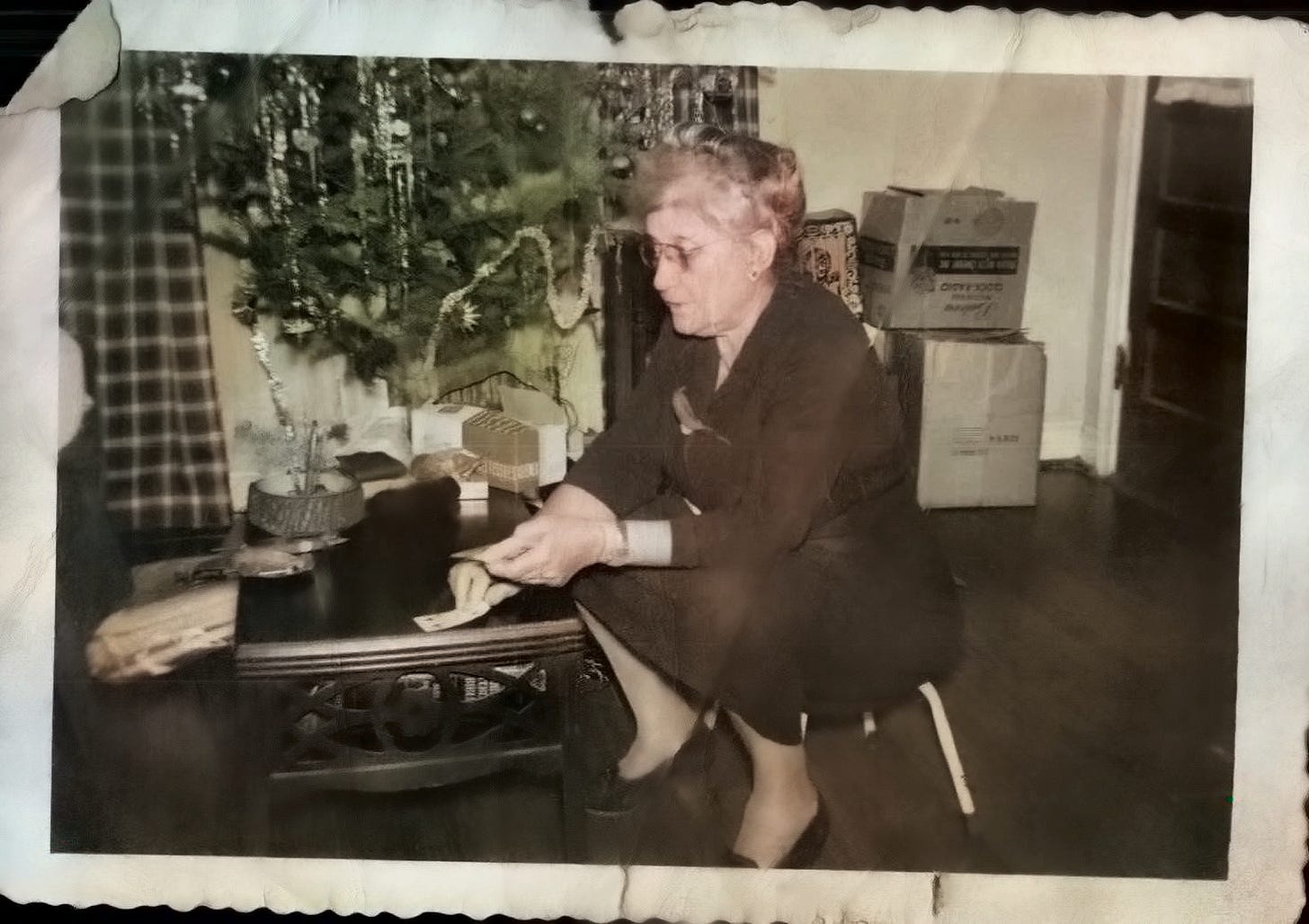Breast Cancer: Averted by a Hare
A 38-year-old wife and mother reaches out for life-saving medical advice from psychic Edgar Cayce, her former Sunday School Teacher
"The doctors may be good, but they are too anxious to cut, and I don't want to be cut if there are other ways out." Mamie Gray to Edgar Cayce, 2/6/1930
Mamie Butler Gray with her grandson, 1943
Jolly, fun-loving, gregarious, and outspoken were adjectives used to describe Mamie Butler Gray. Eccentric, however, was the favorite descriptor, thanks to her deep-seated belief in spirit communication, and her three-decade-long friendship with psychic Edgar Cayce, whose trance readings she believed had saved her from undergoing a mastectomy.
Most everyone to whom she told her story scoffed at the notion, as Cayce—a photographer and Bible study instructor with no medical training and an eighth-grade education—had recommended a seemingly preposterous psychic prescription: that she inject herself with blood from a rabbit and subject herself to high-frequency discharges from a Nikola Tesla "Violet Ray" appliance. This was as outrageous a notion as when the same skeptics dismissed a medical recommendation Cayce had provided Mamie's uncle: an organ transplant—something that wouldn't be performed for another half-century.
Mamie Gray seated in a wheelbarrow at her family's Selma, Alabama, home in 1926
Mamie, born in 1891, was the eldest daughter of Walter Butler, a Selma, Alabama, businessman whose Broad Street bookstore was three blocks away from the Cayce Art Company, where Edgar Cayce took portrait photographs, printed and developed film stock, and sold fine art and framing supplies.
Mamie Butler's family operated a bookstore at 122 Broad Street
Edgar Cayce's photo studio was at 21 ½ Broad Street (the ½ designator was because the studio was on the second floor
Edgar Cayce purchased the H.P. Tressler Studio (pictured here) before it became the Cayce Art Company
Everyone in Selma knew the Cayce studio because of a roulette-style game that Edgar devised to draw attention to paying customers and to attract new customers. He placed a large clock in a wooden case, prominently displayed on the sidewalk in front of the entrance stairs. Portraits of patrons whom Cayce had recently photographed showed on a pinwheel in place of the clock numerals. Passersby were invited to guess whose portrait would be nearest the clock's second hand when, after 8 days, the clock wound down and stopped ticking. Winners were awarded cash prizes and a discount on a future portrait that they, too, could expect to be prominently displayed on Selma's main thoroughfare.
Edgar Cayce's roulette wheel "photo clock" on the street in front of the Cayce Art Company
Like nearly everyone who strolled Selma's business district, the extended members of the Butler family—17 or more in all—delighted in playing the photo-clock game. They not only had their portraits taken, but they knew Edgar from the Disciples of Christ Christian Church, on what is now Martin Luther King Boulevard, where Mamie's father Walter was an elder and Edgar taught Sunday School to Mamie and other church youth. Edgar's Bible study program was so popular that members published their own newsletter, and teens attended from nearby churches.
Edgar Cayce's Sunday School class published their own newsletter, "The Sevenette," named because Cayce’s bible study was held in classroom 7.
Edgar was Mamie's favorite teacher. He told Bible stories as if he had been there (and indeed he had lived in Biblical times, as had she, in previous incarnations, one of the reasons she was drawn to him). But the greatest impact on Mamie and her family was Edgar's gift as a psychic diagnostician, a vocation he practiced by appointment only and without charge, from a sofa in the backroom of his studio. There, among assorted props Cayce used as backdrops, he would lie on a sofa, enter a self-induced trance, and psychically examine a subject's body, organ by organ.
Back Room of H.P. Tressler Studio, pictured here, where Edgar Cayce later made portrait photographs and gave trance readings.
Mamie's cousin, Flora Butler, confined to the Bryce Hospital mental asylum in Tuscaloosa, was one of the first family members to receive trance medical advice. In a most remarkable reading conducted in 1918—one that "Many Mansions" author Gina Cerminara researched extensively—Cayce identified the root of the problem as an infected wisdom tooth that affected a nerve leading to her brain. Her jaw x-rayed and the tooth removed, Flora was miraculously cured.
Female patients in an east wing ward of the Bryce Hospital when Flora Butler was a patient.
Even more remarkable was the organ transplant reading Cayce gave for Mamie's uncle, Alfred B. Butler. Cayce identified advanced cancer in Alfred's bladder, stomach, and kidneys, and recommended an operation which he said could be performed at the Mayo Brothers Clinic in Minnesota. In what must have seemed like science-fiction, surgeons were to substitute Alfred's diseased organs with those from a living animal. As reported by his son Roger Butler, who attended Cayce's Bible study classes with Mamie, such an operation seemed so unfeasible that no one acted on Cayce's advice. After all, this was 1918. Not until 1954 was the first successful organ transplant performed between humans, and it would not be until 1984, when an infant girl, popularly known as "Baby Fae,” received a baboon's heart. Today, hundreds of thousands of heart patients have received valve replacements made from animal tissue, and thanks to gene-editing technology, surgeons are well on their way to using animal replacement parts for damaged corneas and kidneys.
After the family received these and other medical readings, but before Mamie requested one of her own, Cayce arranged for her, then aged 22, to be introduced to a fellow parishioner, 27-year-old Abiel Wood Gray, whom she married in 1913. As Anne Butler Hall explained in "Ever the Same," an unpublished memoir of the Butler family's decades-long relationship with the Cayces, the need for a formal introduction was not because Mamie was incapable of introducing herself. Just the opposite. Like her mother, she could be embarrassingly outspoken. But proper etiquette required that members of the opposite sex be formally introduced before speaking directly to one another. The long-running family joke was that once Mamie began communications with Abiel Gray, they couldn't be stopped, not in this life or the next!
Cayce himself, in a past-life reading conducted for Mamie in 1927, provided insights into her character that were much in keeping with what family members have shared and how an Alabama newspaper columnist bluntly described her: "Mamie is independent to the point of being annoying."
In reading 2457-2, Cayce declared her "one that is often misunderstood by others, one that finds many contrary-wise conditions…one that brings much joy, much happiness, in the lives of many," and "one that has many qualities that are exacting in others and not so exacting of self."
Medical advice that Cayce gave to Mamie and Abiel's daughter in 1923, to a second daughter born to them a year later, and for a son born in 1933, proved to be just as accurate. Their baby boy, who was named Edgar Gray in honor of Edgar Cayce, became the subject of another long-running family joke because the child hadn't cried at birth. "The doctor found he was tongue-tied," Mamie's mother reported to Cayce. "Think of anyone being kin to me [and Mamie] being tongue-tied!"
Mamie and her husband, Abiel Wood Gray, in the early 1940s. Abiel Gray, a jeweler and optometrist, also championed Edgar Cayce's readings. Mamie said that he was so taken with a business reading that he received that he "wore it out carrying it in his pocket - read it every chance he had."
After the Cayces moved to Virginia in 1925, Mamie was a frequent correspondent and visitor. Knowing how remote and desolate conditions were then in Virginia Beach, she shipped the Cayces a box of hatchling hens, "biddies," to accompany a cow sent by Edgar's mother.
As outspoken in her correspondence as she was in person, Mamie shared family challenges with the Cayces as they arose. Her husband sometimes drank to excess. Her daughter was dating out of the faith. Her sister suffered from mental health issues. However, none of this compared to the dread and apprehension she experienced when she self-examined her breasts. Cancer ran in her family.
"The lower half of my left breast was hard and had red streaks running through the upper half," she wrote to Edgar on March 22, 1930. "I am [emotionally] up one day and down the next. Seem to be too young for what ails me… All I can do to hold this pen. The least exertion gets me. For one who has always been so active this condition floors me... Can't even drive... Now you know I'm in bad shape..."
Mamie Gray around the time she received reading 2457-4
Cayce immediately scheduled a medical reading which was conducted in Virginia Beach on April 2, 1930, while Mamie was in her home in Alabama. Cayce's diagnosis appears in the first paragraph of trance reading 2457-4.
“Conditions are not so well with the body… The activity of forces…are beginning to become in the manner of producing within the system an element as of its OWN resuscitation, living upon the life OF the body-physical. That's a very good description of cancer, isn't it? For it IS malignant in its nature, and has already attacked the mammary glands, and is going to be rather fast in its operation unless there are means taken as to check same.”
Cayce then advised injecting a serum made from the tendons of an animal, preferably a hare. Cayce referenced what was commonly called a "wolve" or a "wolf" which is when both left legs of a rabbit are removed in preparation for cooking.
Asked how she was to obtain this serum, Cayce declared that she would have to manufacture it herself. This wasn't a medication available in a pharmacy—or anywhere else.
Cayce described the procedure in the ninth paragraph. Based on this reading and outlined in a similar breast-cancer treatment reading Cayce conducted, the rabbit was to be exposed to, or injected with, cancer cells from the patient's breast. The antibodies produced by the rabbit would then be prepared into a serum and injected back into the patient's breast.
"There must necessarily be experimentations, with the proper heat, the proper precautions taken as to the character of cell as is destroyed in the culture made and in the activity of the animal as well as human when being used," Cayce told Mamie. "But for this character of the condition this would be MOST effective in at least fifty percent of such ills."
Mamie is also advised to treat herself with "medicated ash."* She was to consume at least an eighth grain mixed with water three times each day, and as outlined here and in numerous other Cayce readings, she was to apply the electric discharge from a Violet Ray to her body. The Violet Ray appliance, invented by Nikola Tesla, was a form of high-frequency low current electrotherapy which was hugely popular in the 1920s but today is largely unknown.
(above) A Nikola Tesla inspired Violet Ray appliance and (below) advertising from 1921
In conjunction with these treatments, Mamie was recommended to stay on a strict diet. "Feed ALL the food that is of a NOURISHING nature, but not from MEATS. Those of cereals, fruits, vegetables, AND such—or principally of the nature that are the foods of the hare, the foods of the beef - these are DESTRUCTIVE forces TO such as may be seen in the condition attacking system."
This sums up Cayce's recommendations. As Mamie's medical records no longer exist, there is no way to scientifically determine the efficacy of the treatment or even know the degree to which she adhered to Cayce's recommendations. All that can be said with certainty is that she committed herself to all or part of the recommendations, that she lived for the next 40 years, and that she died peacefully in her sleep at age 75 without a recurrence of the condition she described. And "eccentric" as the recommended treatments seemed in 1930, medical science appears to be catching up, just as it did with her uncle's organ transplant reading.
Among the most recent discoveries was one outlined in a research study published in medical journals in August 2020. This study conclusively demonstrated that antibodies derived from rabbits had pronounced therapeutic effectiveness on breast cancer cells.** This is not all. The National Cancer Institute itself has acknowledged that the highly specialized antibodies derived from rabbits have transformed our ability to detect and treat diseases such as cancer and HIV. The apparent reason, researchers agree, is that the rabbit's immune system is unique from other animals because they produce antibodies particularly effective on humans. If only Cayce's medical recommendations had been taken seriously a century earlier, who knows how many lives might have been saved!
Research into medicated ash, which has variously been referred to as "animated ash" and "carbon ash," has also received attention, most notably the result of health practitioners in Houston in the 1980s who were experimenting with Cayce's carbon ash health treatments to boost the immune response in HIV patients. Try as they did, the health practitioners couldn't achieve results. Other of Cayce's medical treatments performed spectacularly; just not carbon ash used in tandem with the ultraviolet light (considered an effective substitute for a Violet Ray appliance.) While researching why this might be the case, they compared notes with chemistry professors Richard Smalley and Robert Curl at nearby Rice University, who were also conducting experiments using carbon ash. The take-away from this meeting was nothing less than spectacular.
The Cayce researchers discovered that the commercially produced product they had been using did not possess the same molecular structure as the product available in Cayce's day. To achieve success, they had only to switch out the commercially produced product for the carbon ash which the Rice University professors made for themselves in their laboratory. In the process, the Cayce researchers came to a theoretical understanding of how and why the Cayce treatment worked as it did. After oral ingestion of the ash, carbon particles were released into the bloodstream. Exposed to the ultraviolet light, the particles vibrate, releasing oxygen. A more oxygen-rich environment strengthens healthy cells and weakens cancer cells. Less understood, but still relevant, there appears to exist a bonding action between the carbon particles and the damaged cells that also proves to be highly therapeutic.
This was just the start of the story that would reach national prominence a few years later. In their ongoing discussions, the Cayce health practitioners pointed out to the Rice University professors how their immune-boosting research with carbon ash was far more effective when administered in tandem with exposure to ultraviolet light. The Rice University researchers were not only delighted by this discovery, but that knowledge reportedly contributed in a modest way to professors Smalley and Curl winning the Nobel Prize in Chemistry in 1996 for the discovery of a new form of carbon, what they called product C-60. The degree to which their discovery was foreshadowed by the Cayce readings is the subject for another article.
Sadly, further investigation of the possible uses of a combination of ash and ultraviolet light for medical treatments does not appear to be forthcoming. Nor is there a rabbit serum readily available to women with breast cancer.
Mamie, however, didn't need medical authorities to legitimize the efficacy of these treatments. She knew Cayce had saved her life and didn't hesitate to relate the story to anyone who would listen.
Gray family portrait from the late 1940s. Wood and Mamie's two daughters flanking their parents and young brother Edgar, center
Mamie regretted that Edgar didn't live long enough to meet her grandchildren. She did, however, have the pleasure of knowing Edgar's grandson, Charles Thomas Cayce, who would take over the Cayce work from his father Hugh Lynn Cayce by becoming the director of Edgar Cayce's Association for Research and Enlightenment (A.R.E), in Virginia Beach.
Mamie Gray playing with Edgar's grandson Charles Thomas Cayce, 1945
Mamie never found another psychic as good as Edgar, but this didn't stop her from looking. One medium of whom she became fond lived in St. Petersburg, Florida. Several times a year, Mamie traveled south from Selma to attend her seances and communicate with deceased relatives.
Family historian Anne Butler Hall recalls how Mamie's father would routinely tease her by asking how Grandpa Butler was doing in heaven. Mamie would laugh and launch into her latest contact with the spirit world.
On one occasion, Mamie reported to family members that the ghost of Grandpa Butler had playfully tugged on her hair. She laughed and told the ghost: "You stop that, you scamp!" The response from exasperated relatives was expected. "Mamie, you don't [honestly] believe in that stuff!" But she did.
Anne Butler Hall reports that on another occasion, Mamie told the family that she "dreamed" that her husband, Abiel Wood Gray, in bed beside her, playfully swatted her on her buttocks as he was on his way out of their bedroom. Several maiden aunts blushed and looked away as Mamie narrated this part of the story. But this was not all. When Mamie awoke the following morning, she found that he had died in his sleep. Instead of being grief-stricken and inconsolable over his death, Mamie accepted what she had been foretold in her dream as a blessing. She calmly called the funeral home and told them to send the hearse to "Come get Wood's 'overcoat.'" By this, she meant his body.
"That's how it was for Mamie," Hall reports. "Because of her spiritual beliefs in life after life, Mamie level-headedly viewed death as just another natural process, not to be feared or dreaded. That's the legacy she passed onto her children, grandchildren, and all of us, her extended family."
Mamie Butler Gray before she died peacefully in her sleep at age 75, on March 6, 1966
Note to the Reader: The information contained in this article is not intended for self-diagnosis or self-treatment. Please consult a qualified health care professional for assistance in applying the information.
*Many health practitioners working with the Cayce readings believe the term "medicated ash" to be synonymous or used interchangeably in the readings with "animated ash" and "carbon ash." Baar Products, supplier of Edgar Cayce health and beauty products, manufactures both Anidex® (animated ash) and Carbondex® (carbon and medicated ash), and offers customers a detailed reference manual. They also sell the Violet Ray machine. Interested parties should contact Baar Products, 610-873-4591, or www.baar.com. Readers are also encouraged to download the two "circulating files" on breast cancer from Edgar Cayce's Association for Research and Enlightenment (A.R.E.) which can be found in the members-only section of EdgarCayce.org
**This article can be found at: https://translational-medicine.biomedcentral.com/articles/10.1186/s12967-020-02484-9#Sec2 see also: https://www.nature.com/articles/emm201723 and https://www.abcam.com/primary-antibodies/reasons-why-rabbits-are-capable-of-producing-superior-antibodies
The authors gratefully acknowledge the help of Anne Butler Hall and her memoir, "Ever the Same, Edgar," in writing this article. Thanks, also, to Mamie's son, Edgar Gray, his wife Kathryn, and their five children. For their medical and other Cayce health treatment insights, thanks go to Ed Jamail and Bruce Baar. Reference materials and photographs have been generously provided by the Selma-Dallas Historical Society, Anniston Star Newspaper, The Selma Journal, The Alabama Department of Archives and History, the Edgar Cayce Foundation Archives, and the Richard E. Smalley Institute for Nanoscale Science and Technology at Rice University in Houston, Texas.
If you have enjoyed this and other of our articles, please share cayceuniverse.com with your like-minded friends. Personal referrals are how our readers find us.
Sid and Nancy Kirkpatrick

